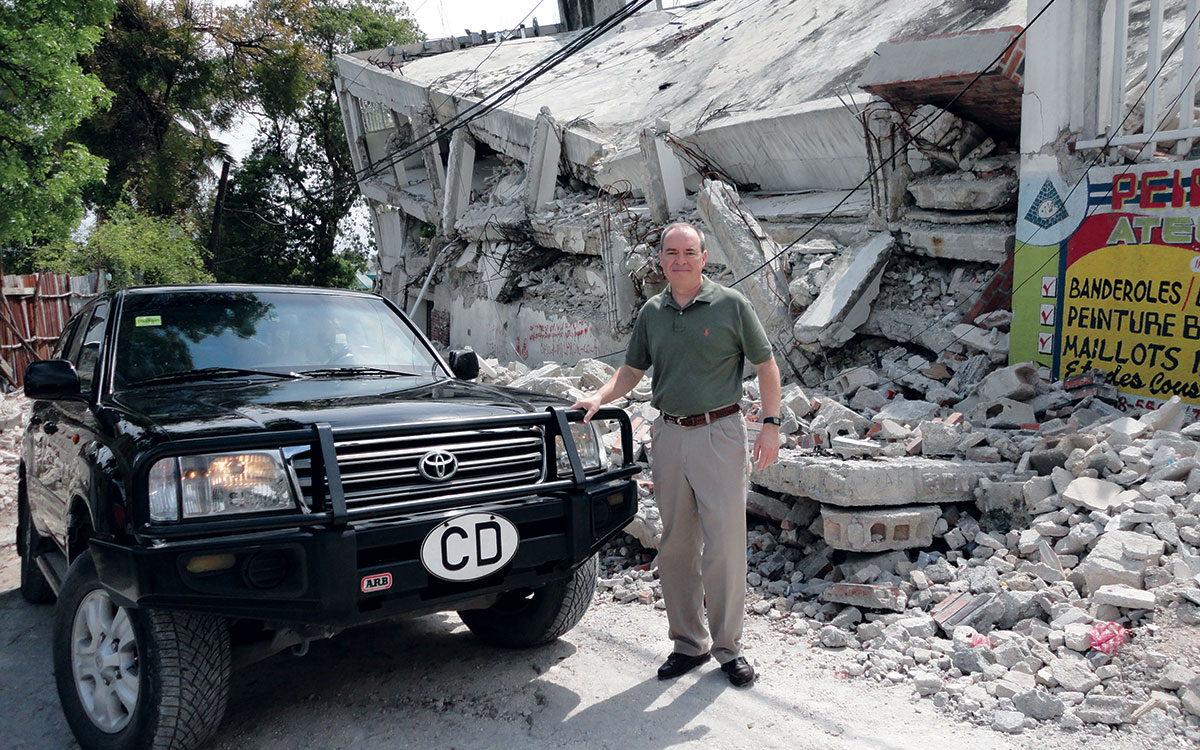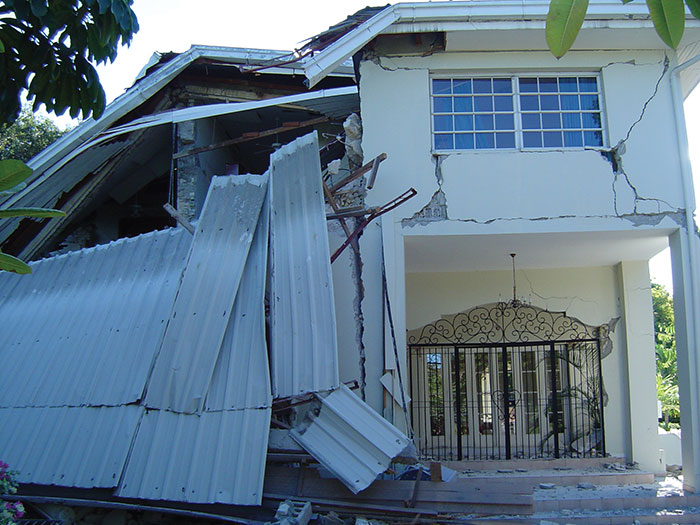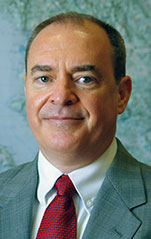A Night to Remember
On Jan. 12, 2010, a sunny afternoon turned into a nightmare. America’s deputy chief of mission in Haiti shares his record of the first hours of the catastrophe.
BY DAVID LINDWALL

On Jan. 12, 2010, author David Lindwall was stuck in traffic up on Delmas Boulevard, a main thoroughfare leading down from the top of a hill to the plain in Port-au-Prince. About 30 feet away, set back from the road, the building shown here “pancaked” before his eyes. Six weeks later he returned to take this photo marking the place and time he realized that the sound of thunder heard on that sunny afternoon was, in fact, an earthquake.
Courtesy of David Lindwall
What sounded like a deafening peal of thunder on a bright, sunny day made my driver, Raoul, and my bodyguard, Dominic, glance at each other in surprise. We were in upper Delmas, in the heights above Port-au-Prince, Haiti, heading down the commercial boulevard on the afternoon of Jan. 12, 2010. Raoul and Dominic were tense, uneasy. I pulled the earphones of my iPod out of my ears and stuffed them in my briefcase. The thunder peal was getting louder and closer.
Suddenly the heavy concrete floors of a four-story office building on the right side of the car began slamming down one on top of the other. Thud! Thud! Thud! The huge glass windows shattered into the street. I tried to dial the State Department Operations Center on my BlackBerry, but I didn’t have my reading glasses on and, in my nervousness, I couldn’t get the numbers right.
Dust was rising from buildings that lay in crumpled heaps. I told Raoul to turn around and head back to the embassy.
“No, boss, we have to get you to your house.”
“Raoul, we have to head back to the embassy!”
Ignoring me, he turned the car into a side street toward my house, but we hadn’t gone 50 feet before the rubble completely clogged the street. There were wounded people walking aimlessly in front of us, and cars had been crushed like soda cans.
We turned on the embassy radio. The excited cacophony of Creole voices was dizzying. The guards at embassy residences were reporting damage to the houses they were assigned to, most not realizing that the entire city had been hit. I asked Dominic what they were saying.
“The lady, she walked into the house, and it collapsed,” he translated. The guard kept repeating the same line in increasing tones of despair.
I asked Dominic to ask the guard who the lady was. Even through his thick accent I could make out that the guard was saying “Victoria DeLong”—the embassy’s cultural attaché.
As we drove through the poor neighborhood of Tabarre, I could hear the wailing voices of young women in the darkness and could only imagine the losses they must have been grieving.
Upper Delmas had been badly hit, and many buildings had pancaked. The sidewalk market ladies who had been sitting in the shade of the buildings on Delmas had failed to run, and many lay dead on the sidewalk, crushed by chunks of concrete the size of refrigerators. The survivors were coated head to toe with a fine white powder from disintegrating concrete and plaster. It looked like the end of the world. We drove past many people, mainly women, on their knees with their arms stretched up to the heavens. Through the bulletproof glass I could hear them wail, “Pitye, Jesi! Pitye, Jesi!” (Have pity on us, Jesus!)
Traffic had become chaotic. At the intersection that led toward the embassy, two nervous policemen waved drivers on. I could see that the Caribbean Market, where I did all my grocery shopping, had collapsed and slid across the street cutting off the road. The car came to a total stop as dusk was setting in. I asked Dominic to look for a flashlight, because we would be walking the roughly 10 miles back to the embassy.
“Give me two minutes, two minutes!” he shouted breathlessly, and jumped out of the car.
Before I knew it, he had stopped a motorcycle and convinced its owner to take the two of us down the mountain to the embassy.
The motorcycle wasn’t very big, but it was clear the driver was used to carrying two passengers, maybe more. We sped off through the chaotic traffic. Rumbling through my head was the voice of a high school friend: never ride a motorcycle without a helmet. So many roads were blocked by rubble, and the driver headed off on a dirt trail that led up into the mountains through the shantytowns. Every time he reached a steep grade, Dominic and I would have to get off the bike so the driver could make it through the ruts to the top of the hill. The trail led through a very poor neighborhood that was miraculously unscathed by the quake. The residents were all in the streets looking down on the chaos below.
It was dark by the time we got off the mountain and back on the avenue that led to the embassy. As we drove through the poor neighborhood of Tabarre, I could hear the wailing voices of young women in the darkness and could only imagine the losses they must have been grieving.
Embassy officers and their spouses from the housing complex across the street had gathered on the steps of the embassy. We nervously exchanged news. Regional Security Officer Steve Lesniak, Marine Security Guard Detachment Commander Staff Sgt. Jamie Long and the Marines were all in Post One. With phone lines and cell phones not working, they reached out to the embassy community over the radio and had established contact with about half of the American employees. They confirmed the news about Victoria DeLong, and told me that three other official Americans had been critically injured and were in the process of being rescued from the rubble of their homes.
I was able to talk to Ambassador Ken Merten by radio. He and his family were trapped in the residence; landslides had cut the one road out in numerous places. Embassy families that lived near the ambassador’s residence were gathering there, and several injured survivors of the collapse of the Hotel Montana had been taken there for treatment.
Consul General Don Moore had made contact with the State Department through the embassy satellite link, and I joined him in his office to update the Operations Center on what we knew about the situation in Port-au-Prince. I had hardly gotten on the phone with Ops when they passed me to the Secretary’s office. After an exchange of brief but heartfelt greetings with the Secretary’s counselor, Cheryl Mills, Secretary Hillary Clinton came on the line. I told her Port-au-Prince had suffered a catastrophe of biblical proportions. We were working to free several embassy officers from the rubble, and it was possible that there had been embassy fatalities. I described the destruction I had witnessed in Delmas and told her that our guards were reporting the same all across the city. The Secretary told me her thoughts and prayers were with us, and said she had set up a task force that would work through the night to get us relief.
Three embassy houses on a ridgeline had collapsed and slid down the hill.

The author’s residence in Port-au-Prince, after the earthquake.
Courtesy of David Lindwall
The embassy building had survived the earthquake, but the upper floors had been badly shaken. Ceiling tiles and lights had fallen. Lamps and computers were all on the floor. Bookcases were overturned. It took me 15 minutes to get everything picked up off the floor of my office and the computers back up and running. Intending to fix a pot of coffee, I stepped into the front office kitchen only to see the contents of the refrigerator and the cabinets all shattered on the floor. Shards of glass and white porcelain carpeted the floor and filled the open kitchen drawers. I couldn’t deal with it. Coffee would have to wait.
Under Secretary for Management Patrick Kennedy and Southern Command Deputy Commander Ambassador Paul Trivelli hastily organized a task force in Washington to deal with the crisis. Much of my night was spent in long conversations with them. They asked if the airport was open. The lights of private planes could be seen taking off regularly as anyone rich enough to get away from the apocalypse was loading their families, in some cases their injured, into their own aircraft and flying them to Santo Domingo or Miami, or any place where the earth didn’t shake.
Three embassy houses on a ridgeline had collapsed and slid down the hill. Our human rights officer and her husband and the noncommissioned officer from the defense attaché’s office were trapped in the rubble. Their neighbor, Security Officer Pete Kolshorn, and a couple of Haitian guards worked tirelessly into the night to rescue them. With violent aftershocks rearranging the rubble every 15 minutes, the rescue operation put the rescuers’ own lives at risk. But they persisted and got their injured comrades up to the top of the ridgeline. All three had broken bones and open wounds. During the two hours it took to get them out of the rubble, we sent a scout to the three hospitals in town. All three were overwhelmed and would not even open their gates to us.
A Haitian doctor who lived nearby gave initial attention to our three wounded colleagues and helped Kolshorn move them several blocks through rubble to the main street. An embassy roving patrol vehicle that had been trapped up in the highlands managed to meet the party on the other side of the rubble. The Haitian doctor advised moving them to the clinic of a plastic surgeon he knew in Petionville. It wasn’t ideal, but it was our only choice. The doctor asked us to send oxygen tanks because one of the male patients had a collapsed lung.
In the expectation that one of our drivers would find a way through the rubble that separated the embassy from Petionville, I asked Dr. Steve Harris, the head of the Centers for Disease Control and Prevention office in Port-au-Prince who had set up a provisional hospital in the embassy’s health unit, to get me all the oxygen, morphine and casting supplies he could spare. There were only two tanks of oxygen. That would not be enough to keep the male patient alive, the Haitian doctor told me; but it was all we had, and we dispatched the driver with the supplies.
Through the night more and more wounded came to the embassy looking for help. One of the ambassador’s bodyguards with open wounds and broken bones came carrying his infant son who had multiple fractures. His wife and other children had all been killed when their house collapsed.
By midnight we still had not located a large number of embassy personnel. With so many streets blocked by rubble, it was a real challenge to reach them. Assistant RSO Rob Little offered to take his motorcycle and go looking house by house. Rob knew Port-au-Prince better than any of us, and at 6 foot 6, he was intimidated by nothing. For the next two hours he drove around the neighborhoods where embassy people lived, assembling them in areas where they could be picked up by our vans as soon as the roads were cleared. Some of the embassy homes had been completely destroyed, but their occupants were miraculously spared. Several officers sustained injuries that were not life-threatening, but required evacuation as soon as we could get flights in the next days. For those huddled together in the dark front yards of ruined houses waiting for an embassy van, it must have been a very long night.
Around 2 a.m. I noticed that the embassy cafeteria had been turned into a makeshift hospital. Americans from all over Port-au-Prince had come looking for help. Some were sleeping on the floors; others were lying on cafeteria tables with IV lines stuck in their arms. A young American woman in her early 20s who had bandages all over her head and shoulders wandered listlessly around the cafeteria.
Back in my office, I was beginning to get emails asking for help. An employee of our embassy in Guatemala asked if I could locate her husband, who was a captain in the Guatemalan Army working as a staff officer with the United Nations peacekeeping force. The wife of a good friend in Nicaragua wrote that her daughter was at the Montana Hotel with a group of volunteers from Lynn University. We were able to evacuate the Lynn University student the next day, and both stories eventually had happy endings.
In every call with the task force in Washington, I would ask for helicopters from Guantanamo at first light to evacuate our injured. After a few hours they told me to expect a helicopter at 8 in the morning. The drivers took the seats out of two vans so that we could put stretchers in the back, and then drove up to the clinic in Petionville. We would be ready to move our three critically injured colleagues to the embassy by 8 a.m.
Hundreds of human figures silhouetted against the rising sun picked through the ruins brick by brick, stone by stone.
Washington, in exchange, kept asking for firsthand information on the airport. At around 4 a.m. the RSO put together a security escort, and we drove to the airport. We drove through the dark and quiet streets of Tabarre, but even the darkness couldn’t conceal the homes and stores and a large hotel collapsed into heaps of rubble like so much crumpled paper. In the parking lot of the airport we found a group of American college students. Terrified by the events of the night, they were hoping to catch the first flight out. We convinced them to go get some sleep at the embassy.
The first rays of sunlight began to lighten the sky as we pulled out of the airport parking lot. The narrow streets of the city center were hopelessly clogged with rubble, so we diverted to the slum of Cité Soleil, where the embassy funded a model community policing program. The small homes with tin roofs of the neighborhood appeared to have weathered the earthquake well, but the schools, churches and other public buildings had succumbed to the weight of their heavy poured-concrete roofs. We passed the police station that the embassy had built at great cost. It looked intact.
Further on, we came to a barricade manned by Bolivian troops of the U.N. stabilization mission MINUSTAH. They were waving everyone away. Our armored motorcade with diplomatic plates gave them pause, and they let us through. We had hardly gotten through the barricade when I saw why they didn’t want traffic on the street. The barracks of the Brazilian U.N. military unit had collapsed, and Brazilian soldiers were swarming the building like ants, removing the rubble to get to their trapped comrades. Hundreds of human figures silhouetted against the rising sun picked through the ruins brick by brick, stone by stone. I later found out that 15 Brazilian peacekeepers lost their lives in that building.
Back at the embassy we dispatched vans to pick up our American personnel scattered all over the city. It was almost 8 o’clock, and Washington assured me again that a helicopter would arrive to evacuate our wounded. A U.S. military officer with compound fractures was being brought down the mountain by Drug Enforcement Administration Chief Darrel Paskett to be evacuated. The two vans with our critically injured Human Rights Officer Kathey-Lee Galvin, her husband and the defense attaché’s staff member were on their way. We received word that the helicopter would only land if we could secure the soccer field adjacent to the embassy. RSO Lesniak grabbed an AR-15, and the two of us headed out to the soccer field. Steve stood prominently at guard so the helicopter crew would know that we had secured the field. The bright sunshine and warm tropical morning felt good after a sleepless night.
Right at 8 o’clock we saw an orange-and-white U.S. Coast Guard helicopter approaching the embassy from the northwest. Once landed, the aircrew looked nervous. They had had a long, two-hour flight across the Windward Passage, and perhaps expected to encounter a riotous scene. They said they couldn’t stay long on the ground and asked where the injured U.S. military officer was. I told them that he was on his way down the mountains, but that our three injured embassy personnel were in the waiting vehicles and could be loaded aboard the helicopter immediately. They agreed to load them up. Both male patients had many broken bones and had been given morphine to calm the pain. Neither responded to me nor gave signs of consciousness.
I walked over to check on Kathey-Lee, who had been strapped to a gurney and was nestled into a large neck brace. Her face was black and blue, and she had contusions running up to the line of her wavy red hair. She responded to my greeting with a sober sense of humor that made me realize she hadn’t touched the morphine I had sent up to the clinic. We exchanged stories of our longest night and news of our colleagues. As the stretcher bearers carried her to the helicopter, I asked Kathey-Lee why she hadn’t taken any morphine. “At a time like this, I want to be the one making the decisions!” she replied.
The helicopter crew wanted to leave, but they wanted to take the injured military officer with them, and he hadn’t shown up. I asked if we should pre-position another patient in the event the injured colonel didn’t make it to the airfield in time. When they agreed, I sent for the young American woman who had come to the embassy with a head injury the night before; but it took a few minutes to find her. The crew chief said they didn’t have a medic on board, and that in view of the serious injuries of the three embassy personnel, they needed to depart immediately. Even if the other patient were there, it was unlikely they would be able to take her due to weight considerations, he said. Just then a vehicle pulled up and the young woman got out. She was in bad shape and walked slowly. When the flight crew saw her, they realized they couldn’t leave her behind. They helped her to the helicopter and strapped her in a back seat. The crew chief turned to me and promised to return for more patients in the afternoon.
I rejoined Steve Lesniak and his long gun on the knoll next to the embassy. The helicopter lifted gracefully off the dusty soccer field as we stood and watched till it disappeared out of sight.
The long night of Jan. 12 was over, but our work had just begun.




